Financial Management Report: Budgeting, Variance Analysis, and more
VerifiedAdded on 2020/03/16
|6
|1588
|34
Report
AI Summary
This financial management report is divided into two parts. Part A addresses the importance of record keeping for businesses in Australia, outlining specific requirements such as sales, purchases, GST, wages, and asset records, which must be maintained for five years. It also explains the audit process, including the evaluation of financial statements by internal or external auditors, and the potential duration of audits. Furthermore, it details the penalties for non-compliance with record-keeping regulations. Part B focuses on Simpsons Pty Ltd, a small takeaway restaurant, and its budgeting process. It includes a schedule of expected revenues, cost of goods sold, and expenses, along with variance analysis for the first quarter. The report analyzes variances in food revenue, food cost, beverage sales, utilities, wages, and rent expenses. Adjustments are made to the budget for subsequent quarters based on these variances, resulting in an improved budget that facilitates better performance measurement. The report concludes with a bibliography of the sources used.
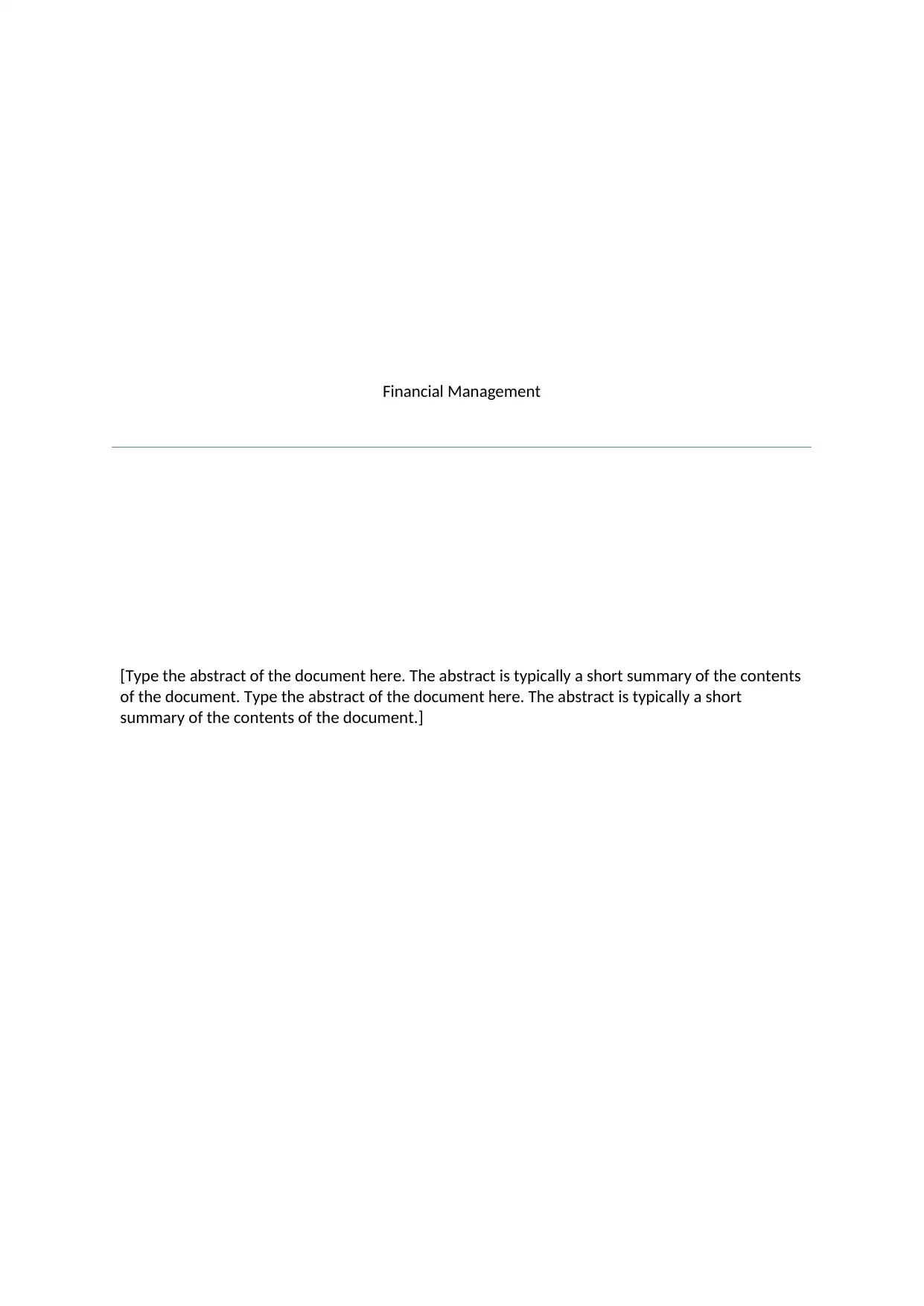
Financial Management
[Type the abstract of the document here. The abstract is typically a short summary of the contents
of the document. Type the abstract of the document here. The abstract is typically a short
summary of the contents of the document.]
[Type the abstract of the document here. The abstract is typically a short summary of the contents
of the document. Type the abstract of the document here. The abstract is typically a short
summary of the contents of the document.]
Paraphrase This Document
Need a fresh take? Get an instant paraphrase of this document with our AI Paraphraser
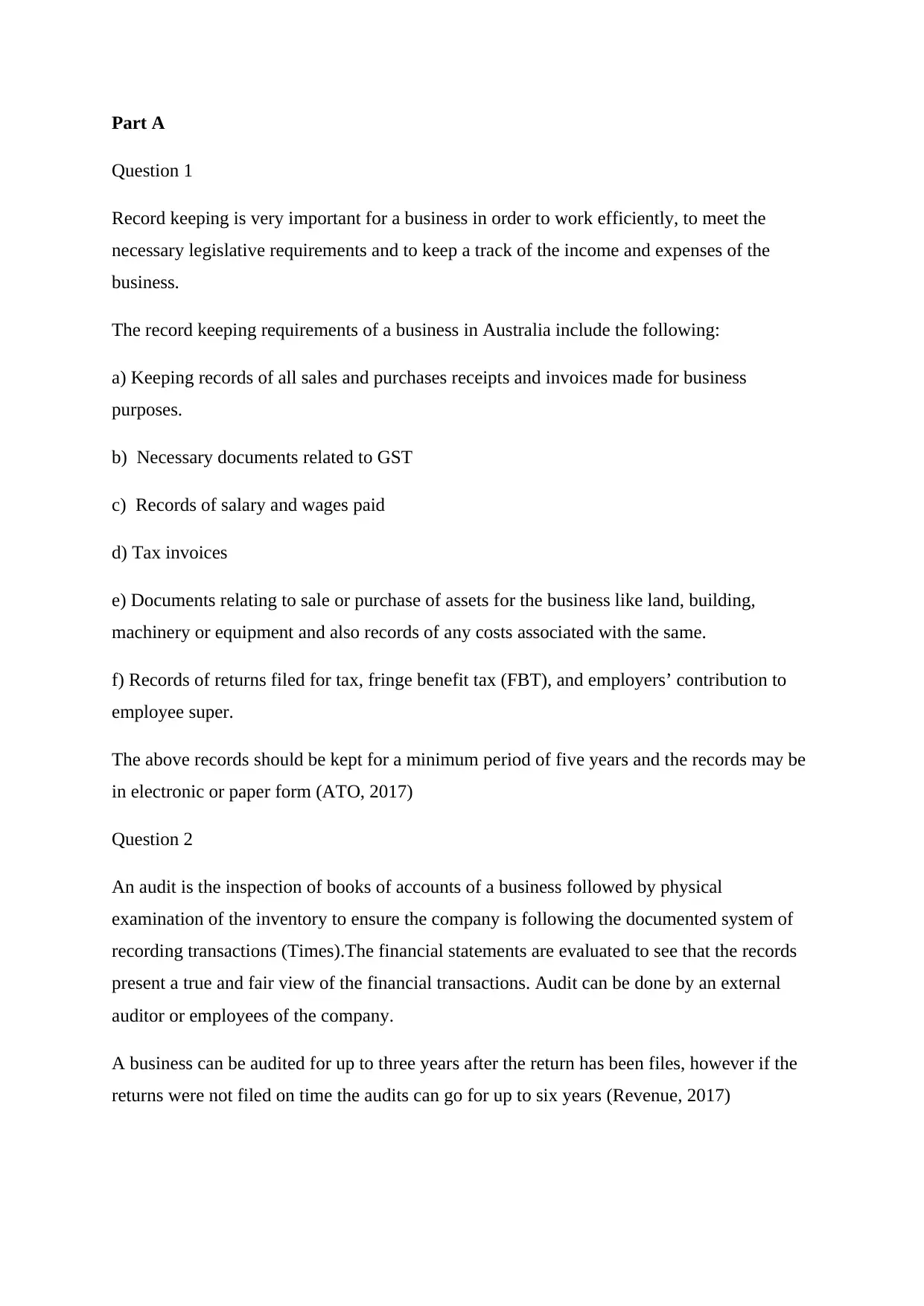
Part A
Question 1
Record keeping is very important for a business in order to work efficiently, to meet the
necessary legislative requirements and to keep a track of the income and expenses of the
business.
The record keeping requirements of a business in Australia include the following:
a) Keeping records of all sales and purchases receipts and invoices made for business
purposes.
b) Necessary documents related to GST
c) Records of salary and wages paid
d) Tax invoices
e) Documents relating to sale or purchase of assets for the business like land, building,
machinery or equipment and also records of any costs associated with the same.
f) Records of returns filed for tax, fringe benefit tax (FBT), and employers’ contribution to
employee super.
The above records should be kept for a minimum period of five years and the records may be
in electronic or paper form (ATO, 2017)
Question 2
An audit is the inspection of books of accounts of a business followed by physical
examination of the inventory to ensure the company is following the documented system of
recording transactions (Times).The financial statements are evaluated to see that the records
present a true and fair view of the financial transactions. Audit can be done by an external
auditor or employees of the company.
A business can be audited for up to three years after the return has been files, however if the
returns were not filed on time the audits can go for up to six years (Revenue, 2017)
Question 1
Record keeping is very important for a business in order to work efficiently, to meet the
necessary legislative requirements and to keep a track of the income and expenses of the
business.
The record keeping requirements of a business in Australia include the following:
a) Keeping records of all sales and purchases receipts and invoices made for business
purposes.
b) Necessary documents related to GST
c) Records of salary and wages paid
d) Tax invoices
e) Documents relating to sale or purchase of assets for the business like land, building,
machinery or equipment and also records of any costs associated with the same.
f) Records of returns filed for tax, fringe benefit tax (FBT), and employers’ contribution to
employee super.
The above records should be kept for a minimum period of five years and the records may be
in electronic or paper form (ATO, 2017)
Question 2
An audit is the inspection of books of accounts of a business followed by physical
examination of the inventory to ensure the company is following the documented system of
recording transactions (Times).The financial statements are evaluated to see that the records
present a true and fair view of the financial transactions. Audit can be done by an external
auditor or employees of the company.
A business can be audited for up to three years after the return has been files, however if the
returns were not filed on time the audits can go for up to six years (Revenue, 2017)
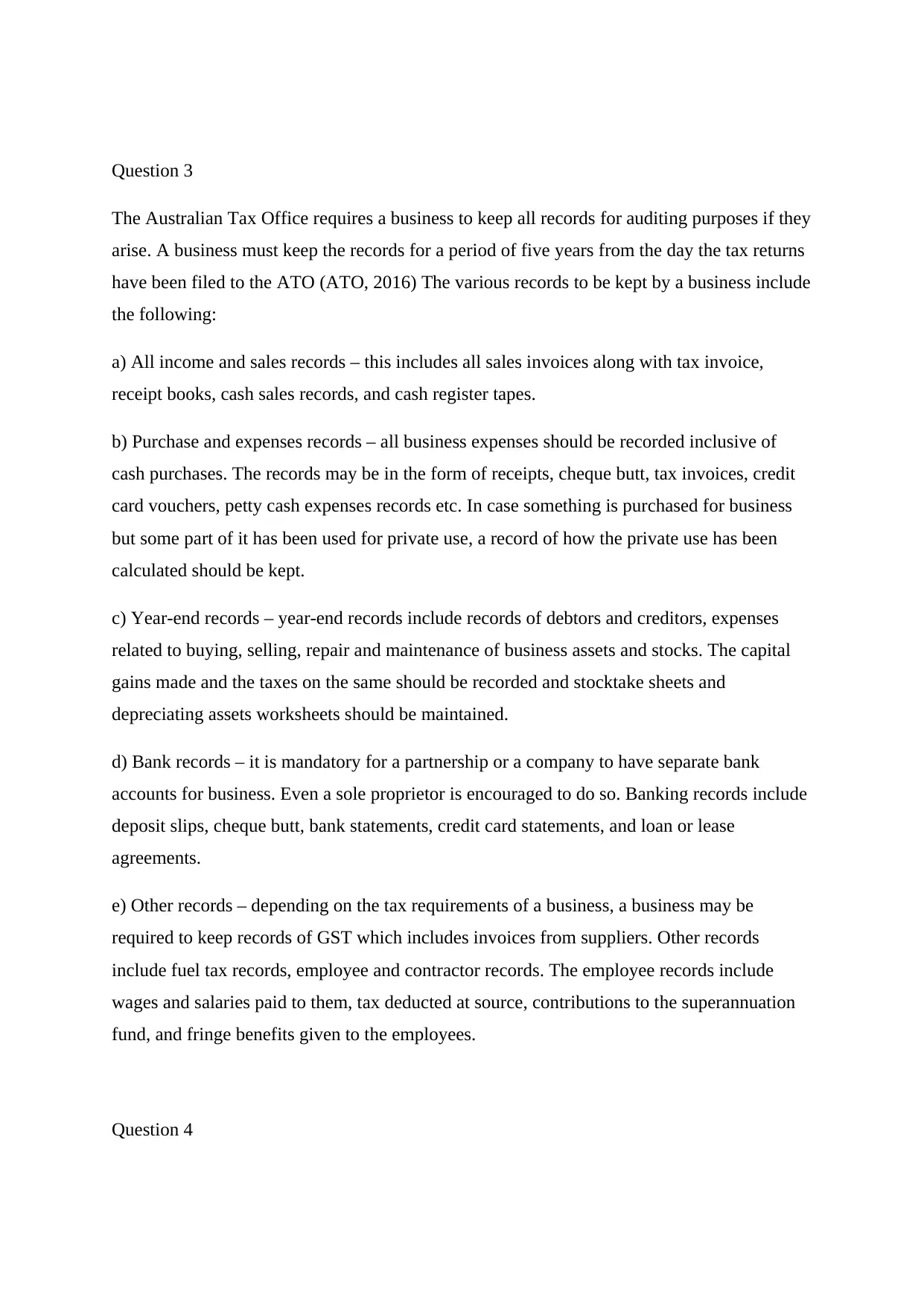
Question 3
The Australian Tax Office requires a business to keep all records for auditing purposes if they
arise. A business must keep the records for a period of five years from the day the tax returns
have been filed to the ATO (ATO, 2016) The various records to be kept by a business include
the following:
a) All income and sales records – this includes all sales invoices along with tax invoice,
receipt books, cash sales records, and cash register tapes.
b) Purchase and expenses records – all business expenses should be recorded inclusive of
cash purchases. The records may be in the form of receipts, cheque butt, tax invoices, credit
card vouchers, petty cash expenses records etc. In case something is purchased for business
but some part of it has been used for private use, a record of how the private use has been
calculated should be kept.
c) Year-end records – year-end records include records of debtors and creditors, expenses
related to buying, selling, repair and maintenance of business assets and stocks. The capital
gains made and the taxes on the same should be recorded and stocktake sheets and
depreciating assets worksheets should be maintained.
d) Bank records – it is mandatory for a partnership or a company to have separate bank
accounts for business. Even a sole proprietor is encouraged to do so. Banking records include
deposit slips, cheque butt, bank statements, credit card statements, and loan or lease
agreements.
e) Other records – depending on the tax requirements of a business, a business may be
required to keep records of GST which includes invoices from suppliers. Other records
include fuel tax records, employee and contractor records. The employee records include
wages and salaries paid to them, tax deducted at source, contributions to the superannuation
fund, and fringe benefits given to the employees.
Question 4
The Australian Tax Office requires a business to keep all records for auditing purposes if they
arise. A business must keep the records for a period of five years from the day the tax returns
have been filed to the ATO (ATO, 2016) The various records to be kept by a business include
the following:
a) All income and sales records – this includes all sales invoices along with tax invoice,
receipt books, cash sales records, and cash register tapes.
b) Purchase and expenses records – all business expenses should be recorded inclusive of
cash purchases. The records may be in the form of receipts, cheque butt, tax invoices, credit
card vouchers, petty cash expenses records etc. In case something is purchased for business
but some part of it has been used for private use, a record of how the private use has been
calculated should be kept.
c) Year-end records – year-end records include records of debtors and creditors, expenses
related to buying, selling, repair and maintenance of business assets and stocks. The capital
gains made and the taxes on the same should be recorded and stocktake sheets and
depreciating assets worksheets should be maintained.
d) Bank records – it is mandatory for a partnership or a company to have separate bank
accounts for business. Even a sole proprietor is encouraged to do so. Banking records include
deposit slips, cheque butt, bank statements, credit card statements, and loan or lease
agreements.
e) Other records – depending on the tax requirements of a business, a business may be
required to keep records of GST which includes invoices from suppliers. Other records
include fuel tax records, employee and contractor records. The employee records include
wages and salaries paid to them, tax deducted at source, contributions to the superannuation
fund, and fringe benefits given to the employees.
Question 4
⊘ This is a preview!⊘
Do you want full access?
Subscribe today to unlock all pages.

Trusted by 1+ million students worldwide
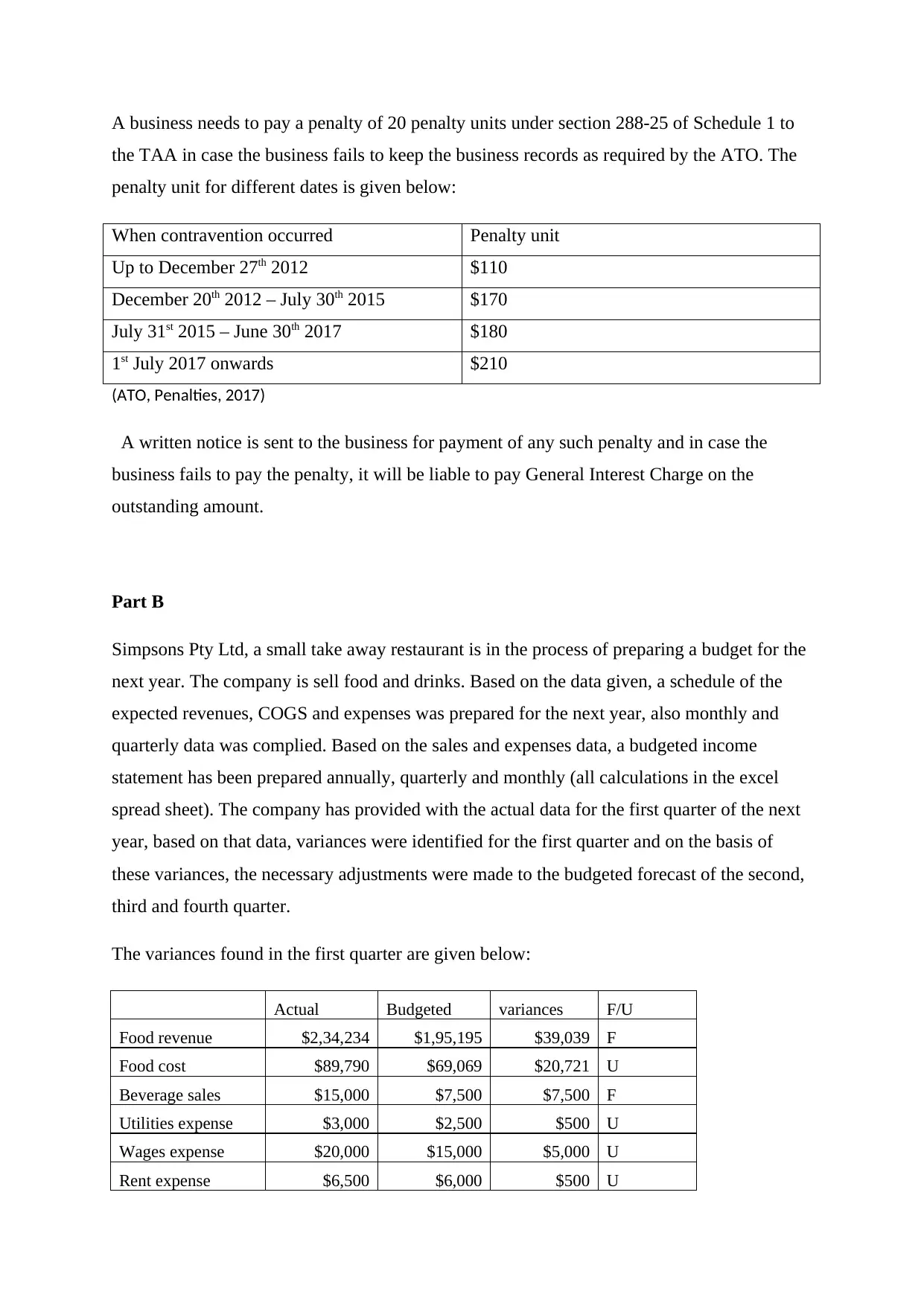
A business needs to pay a penalty of 20 penalty units under section 288-25 of Schedule 1 to
the TAA in case the business fails to keep the business records as required by the ATO. The
penalty unit for different dates is given below:
When contravention occurred Penalty unit
Up to December 27th 2012 $110
December 20th 2012 – July 30th 2015 $170
July 31st 2015 – June 30th 2017 $180
1st July 2017 onwards $210
(ATO, Penalties, 2017)
A written notice is sent to the business for payment of any such penalty and in case the
business fails to pay the penalty, it will be liable to pay General Interest Charge on the
outstanding amount.
Part B
Simpsons Pty Ltd, a small take away restaurant is in the process of preparing a budget for the
next year. The company is sell food and drinks. Based on the data given, a schedule of the
expected revenues, COGS and expenses was prepared for the next year, also monthly and
quarterly data was complied. Based on the sales and expenses data, a budgeted income
statement has been prepared annually, quarterly and monthly (all calculations in the excel
spread sheet). The company has provided with the actual data for the first quarter of the next
year, based on that data, variances were identified for the first quarter and on the basis of
these variances, the necessary adjustments were made to the budgeted forecast of the second,
third and fourth quarter.
The variances found in the first quarter are given below:
Actual Budgeted variances F/U
Food revenue $2,34,234 $1,95,195 $39,039 F
Food cost $89,790 $69,069 $20,721 U
Beverage sales $15,000 $7,500 $7,500 F
Utilities expense $3,000 $2,500 $500 U
Wages expense $20,000 $15,000 $5,000 U
Rent expense $6,500 $6,000 $500 U
the TAA in case the business fails to keep the business records as required by the ATO. The
penalty unit for different dates is given below:
When contravention occurred Penalty unit
Up to December 27th 2012 $110
December 20th 2012 – July 30th 2015 $170
July 31st 2015 – June 30th 2017 $180
1st July 2017 onwards $210
(ATO, Penalties, 2017)
A written notice is sent to the business for payment of any such penalty and in case the
business fails to pay the penalty, it will be liable to pay General Interest Charge on the
outstanding amount.
Part B
Simpsons Pty Ltd, a small take away restaurant is in the process of preparing a budget for the
next year. The company is sell food and drinks. Based on the data given, a schedule of the
expected revenues, COGS and expenses was prepared for the next year, also monthly and
quarterly data was complied. Based on the sales and expenses data, a budgeted income
statement has been prepared annually, quarterly and monthly (all calculations in the excel
spread sheet). The company has provided with the actual data for the first quarter of the next
year, based on that data, variances were identified for the first quarter and on the basis of
these variances, the necessary adjustments were made to the budgeted forecast of the second,
third and fourth quarter.
The variances found in the first quarter are given below:
Actual Budgeted variances F/U
Food revenue $2,34,234 $1,95,195 $39,039 F
Food cost $89,790 $69,069 $20,721 U
Beverage sales $15,000 $7,500 $7,500 F
Utilities expense $3,000 $2,500 $500 U
Wages expense $20,000 $15,000 $5,000 U
Rent expense $6,500 $6,000 $500 U
Paraphrase This Document
Need a fresh take? Get an instant paraphrase of this document with our AI Paraphraser
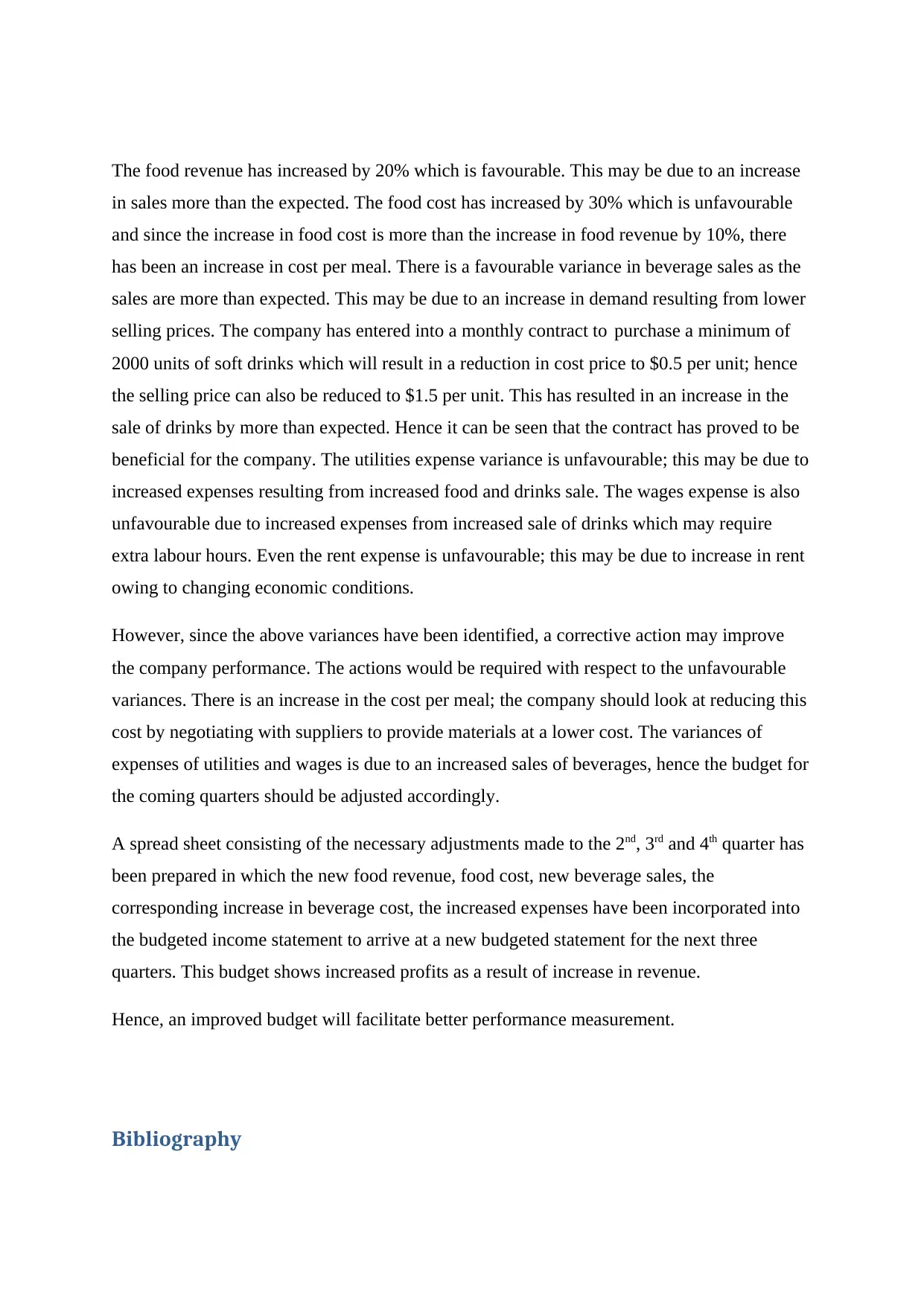
The food revenue has increased by 20% which is favourable. This may be due to an increase
in sales more than the expected. The food cost has increased by 30% which is unfavourable
and since the increase in food cost is more than the increase in food revenue by 10%, there
has been an increase in cost per meal. There is a favourable variance in beverage sales as the
sales are more than expected. This may be due to an increase in demand resulting from lower
selling prices. The company has entered into a monthly contract to purchase a minimum of
2000 units of soft drinks which will result in a reduction in cost price to $0.5 per unit; hence
the selling price can also be reduced to $1.5 per unit. This has resulted in an increase in the
sale of drinks by more than expected. Hence it can be seen that the contract has proved to be
beneficial for the company. The utilities expense variance is unfavourable; this may be due to
increased expenses resulting from increased food and drinks sale. The wages expense is also
unfavourable due to increased expenses from increased sale of drinks which may require
extra labour hours. Even the rent expense is unfavourable; this may be due to increase in rent
owing to changing economic conditions.
However, since the above variances have been identified, a corrective action may improve
the company performance. The actions would be required with respect to the unfavourable
variances. There is an increase in the cost per meal; the company should look at reducing this
cost by negotiating with suppliers to provide materials at a lower cost. The variances of
expenses of utilities and wages is due to an increased sales of beverages, hence the budget for
the coming quarters should be adjusted accordingly.
A spread sheet consisting of the necessary adjustments made to the 2nd, 3rd and 4th quarter has
been prepared in which the new food revenue, food cost, new beverage sales, the
corresponding increase in beverage cost, the increased expenses have been incorporated into
the budgeted income statement to arrive at a new budgeted statement for the next three
quarters. This budget shows increased profits as a result of increase in revenue.
Hence, an improved budget will facilitate better performance measurement.
Bibliography
in sales more than the expected. The food cost has increased by 30% which is unfavourable
and since the increase in food cost is more than the increase in food revenue by 10%, there
has been an increase in cost per meal. There is a favourable variance in beverage sales as the
sales are more than expected. This may be due to an increase in demand resulting from lower
selling prices. The company has entered into a monthly contract to purchase a minimum of
2000 units of soft drinks which will result in a reduction in cost price to $0.5 per unit; hence
the selling price can also be reduced to $1.5 per unit. This has resulted in an increase in the
sale of drinks by more than expected. Hence it can be seen that the contract has proved to be
beneficial for the company. The utilities expense variance is unfavourable; this may be due to
increased expenses resulting from increased food and drinks sale. The wages expense is also
unfavourable due to increased expenses from increased sale of drinks which may require
extra labour hours. Even the rent expense is unfavourable; this may be due to increase in rent
owing to changing economic conditions.
However, since the above variances have been identified, a corrective action may improve
the company performance. The actions would be required with respect to the unfavourable
variances. There is an increase in the cost per meal; the company should look at reducing this
cost by negotiating with suppliers to provide materials at a lower cost. The variances of
expenses of utilities and wages is due to an increased sales of beverages, hence the budget for
the coming quarters should be adjusted accordingly.
A spread sheet consisting of the necessary adjustments made to the 2nd, 3rd and 4th quarter has
been prepared in which the new food revenue, food cost, new beverage sales, the
corresponding increase in beverage cost, the increased expenses have been incorporated into
the budgeted income statement to arrive at a new budgeted statement for the next three
quarters. This budget shows increased profits as a result of increase in revenue.
Hence, an improved budget will facilitate better performance measurement.
Bibliography
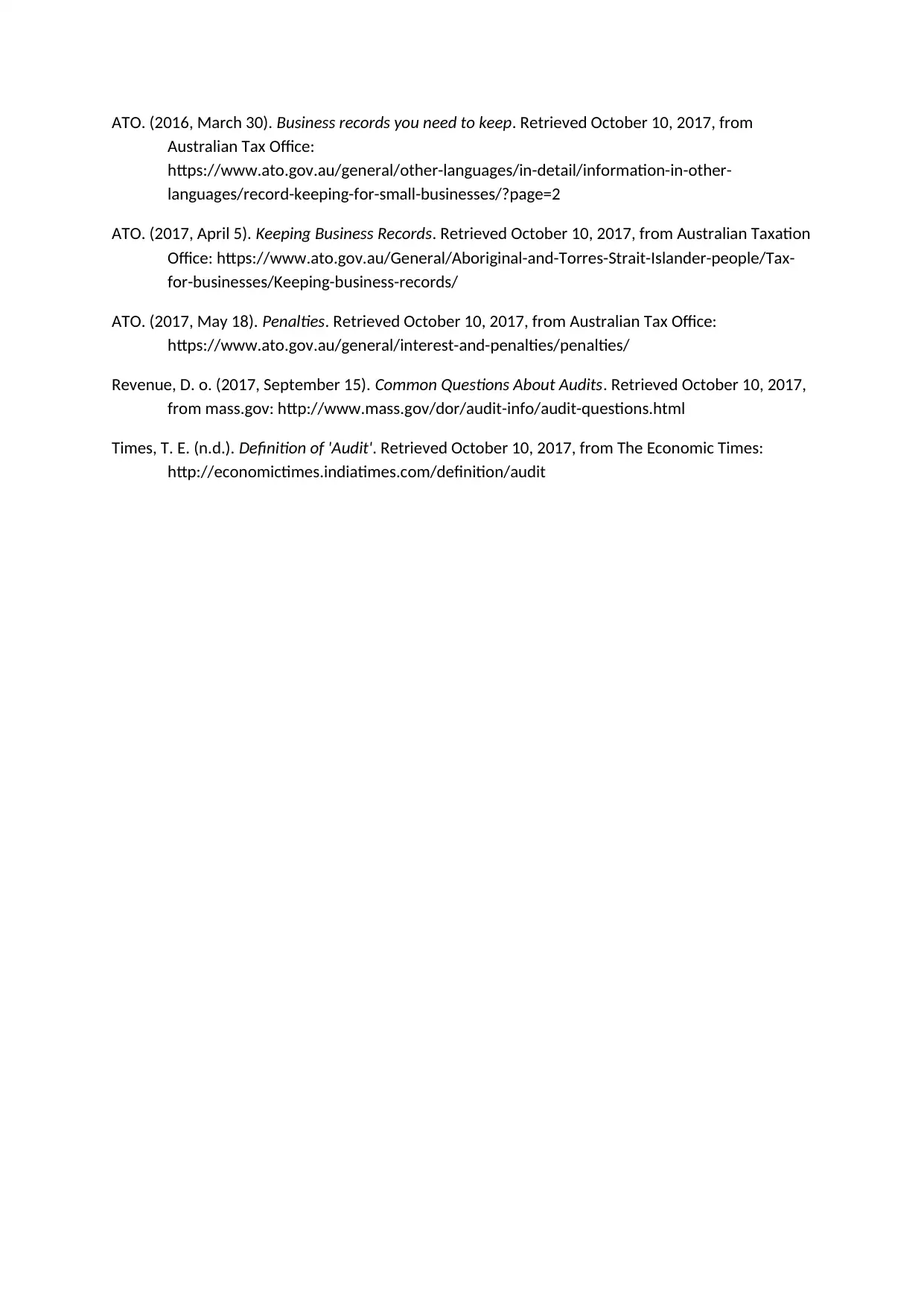
ATO. (2016, March 30). Business records you need to keep. Retrieved October 10, 2017, from
Australian Tax Office:
https://www.ato.gov.au/general/other-languages/in-detail/information-in-other-
languages/record-keeping-for-small-businesses/?page=2
ATO. (2017, April 5). Keeping Business Records. Retrieved October 10, 2017, from Australian Taxation
Office: https://www.ato.gov.au/General/Aboriginal-and-Torres-Strait-Islander-people/Tax-
for-businesses/Keeping-business-records/
ATO. (2017, May 18). Penalties. Retrieved October 10, 2017, from Australian Tax Office:
https://www.ato.gov.au/general/interest-and-penalties/penalties/
Revenue, D. o. (2017, September 15). Common Questions About Audits. Retrieved October 10, 2017,
from mass.gov: http://www.mass.gov/dor/audit-info/audit-questions.html
Times, T. E. (n.d.). Definition of 'Audit'. Retrieved October 10, 2017, from The Economic Times:
http://economictimes.indiatimes.com/definition/audit
Australian Tax Office:
https://www.ato.gov.au/general/other-languages/in-detail/information-in-other-
languages/record-keeping-for-small-businesses/?page=2
ATO. (2017, April 5). Keeping Business Records. Retrieved October 10, 2017, from Australian Taxation
Office: https://www.ato.gov.au/General/Aboriginal-and-Torres-Strait-Islander-people/Tax-
for-businesses/Keeping-business-records/
ATO. (2017, May 18). Penalties. Retrieved October 10, 2017, from Australian Tax Office:
https://www.ato.gov.au/general/interest-and-penalties/penalties/
Revenue, D. o. (2017, September 15). Common Questions About Audits. Retrieved October 10, 2017,
from mass.gov: http://www.mass.gov/dor/audit-info/audit-questions.html
Times, T. E. (n.d.). Definition of 'Audit'. Retrieved October 10, 2017, from The Economic Times:
http://economictimes.indiatimes.com/definition/audit
⊘ This is a preview!⊘
Do you want full access?
Subscribe today to unlock all pages.

Trusted by 1+ million students worldwide
1 out of 6
Related Documents
Your All-in-One AI-Powered Toolkit for Academic Success.
+13062052269
info@desklib.com
Available 24*7 on WhatsApp / Email
![[object Object]](/_next/static/media/star-bottom.7253800d.svg)
Unlock your academic potential
Copyright © 2020–2025 A2Z Services. All Rights Reserved. Developed and managed by ZUCOL.





